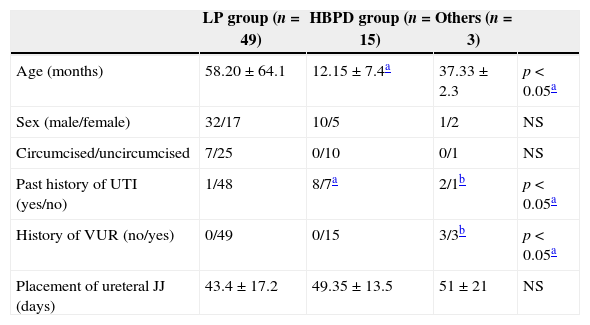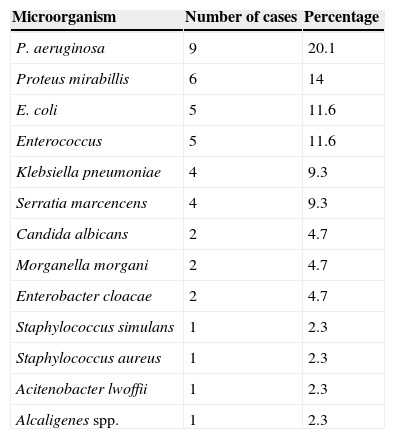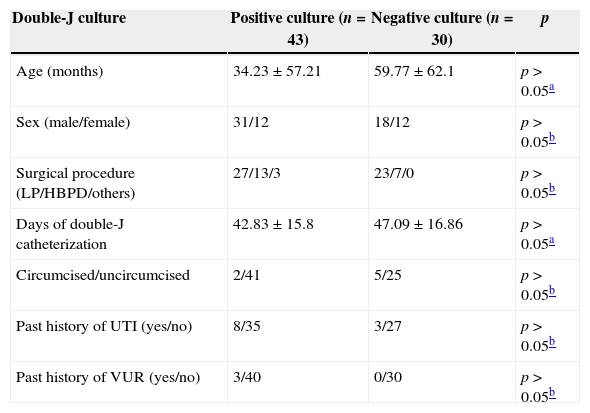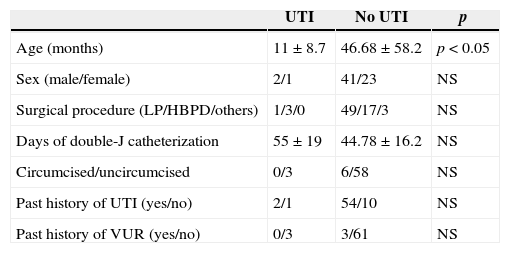To determine the incidence of urinary tract infection in those patients that we have used an ureteral double-J stent as internal diversion after urological procedures.
Materials and methodsWe reviewed all the medical records of patients who had a ureteral double-J stent after a urological procedure from August 2007 to May 2013. We have analyzed the following data: age, gender, type of prophylaxis, incidence of urinary tract infection (UTI), days of internal diversion with double-J stent, surgical procedure, bacterial characteristics, bacterial sensibility to antibiotics and UTI treatment.
ResultsWe have used 73 double-J stents as ureteral internal diversion in 67 patients with a mean age of 44.73±57.23. Surgical procedures were 50 laparoscopic Anderson-Hynes pyeloplasties in 49 patients, and 20 high-pressure balloon dilatation of the ureterovesical junction to treat primary obstructive megaureter in 15 patients; and 3 patients with ureterovesical obstruction after endoscopic treatment of vesicoureteral reflux. Forty three stents showed a bacterial colonization in cultures. Pseudomonas aeruginosa was present in 9 (20.9%) stents. Only in 12 stents, bacterial colonization was sensible to antibiotic prophylaxis. Stent colonization was higher in boys and younger patients. Four patients had a febrile UTI. Incidence of UTI in younger patients that underwent HBPD of UVJ is higher.
ConclusionBacterial colonization is frequent in double-J stents but the incidence of UTI is low. Double-J colonization is higher in younger patients. Patients that underwent HPBD have a higher risk of UTI related with ureteral double-J stent.
Determinar la incidencia de infección del tracto urinario en los pacientes en los que hemos utilizado un catéter ureteral doble J como desvío interno después de procedimientos urológicos.
Material y métodosSe revisaron todas las historias clínicas de los pacientes que tenían un catéter ureteral doble J después de un procedimiento urológico desde agosto de 2007 hasta mayo de 2013. Hemos analizado los siguientes datos: edad, sexo, tipo de profilaxis, incidencia de la infección del tracto urinario (ITU), días de desviación interna con catéter doble J, procedimiento quirúrgico, características bacterianas, sensibilidad de las bacterias a los antibióticos y tratamiento de ITU.
ResultadosHemos utilizado 73 catéteres doble J como desvío interno ureteral en 67 pacientes con una edad media de 44,73±57,23. Los procedimientos quirúrgicos fueron 50 pieloplastias laparoscópicas Anderson-Hynes en 49 pacientes y 20 dilataciones con balón de alta presión de la unión ureterovesical para tratar megauréter obstructivo primario en 15 pacientes, y 3 pacientes con obstrucción ureterovesical después del tratamiento endoscópico del reflujo vesicoureteral. Cuarenta y tres catéteres mostraron una colonización bacteriana en los cultivos. Pseudomonas aeruginosa estaba presente en 9 (20,9%) catéteres. Solo en 12 catéteres la colonización bacteriana era sensible a la profilaxis antibiótica. La colonización del catéter era mayor en los niños y los pacientes más jóvenes. Cuatro pacientes tuvieron una ITU febril. La incidencia de ITU en los pacientes más jóvenes que se sometieron a DBAP de UUV es mayor.
ConclusiónLa colonización bacteriana es frecuente en los catéteres doble J, pero la incidencia de ITU es baja. La colonización doble J es mayor en los pacientes más jóvenes. Los pacientes que se sometieron a DBAP tienen un mayor riesgo de ITU relacionada con el catéter ureteral doble J.










